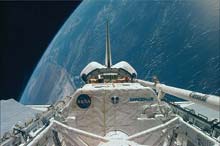
Two University of York graduates have found and preserved the giant tusk of the largest elephant fossil of its type ever to be found in the Middle East.
The tusk, two-and-a-half metres long and thought to be between six and eight million years old, was discovered by Dr Mark Beech, who finished his PhD at York recently and is now senior resident archaeologist for the Abu Dhabi Islands Archaeological Survey (ADIAS).
Mark discovered the tusk in Abu Dhabi’s Western Region last October

European scientists will be ‘turning off’ the effects of gravity during the STS-107 Space Shuttle research mission this month in order to gain a better understanding of processes in medicine, technology and science.
Their investigations will be among some 80 experiments performed during a 16-day mission in Earth orbit to be launched from Cape Canaveral tomorrow.
Seven of the 31 payloads are sponsored by ESA, and the crew will work 24 hours a day in two alternating shifts on experi

Important goal achieved in potential animal-to-human organ transplantation
In a session today at the annual meeting of the International Embryo Transfer Society (IETS), Randall Prather, Ph.D., Distinguished Professor of Reproductive Biotechnology at the University of Missouri-Columbia, announced the successful cloning of the first miniature swine with both copies of a specific gene “knocked out” of its DNA. The ultimate goal of this research, which is being conducted in partnership wi

A research team led by Johns Hopkins scientists has discovered that a special, tiny group of cells at the back of the eye help tell the brain how much light there is, causing the pupil to get bigger or smaller. The findings, which appeared in the Jan. 10 issue of Science, largely complete the picture of how light levels are detected in the eye.
“This tiny group of cells, together with rods and cones, are the bulk of the eye’s mechanisms for detecting levels of light and passing that in

Scientists at The Scripps Research Institute (TSRI) report in an upcoming article in the Journal of the American Chemical Society their synthesis of a form of the bacterium Escherichia coli with a genetic code that uses 21 basic amino acid building blocks to synthesize proteins–instead of the 20 found in nature.
This is the first time that anyone has created a completely autonomous organism that uses 21 amino acids and has the metabolic machinery to build those amino acids.
“We

Climate change had little to do with the demise of the dinosaurs, but the last million years before their extinction had a complex pattern of warming and cooling events that are important to our understanding of the end of their reign, according to geologists.
“The terrestrial paleoclimate record near the K-T is historically contradictory and poorly resolved,” says Dr. Peter Wilf, assistant professor of geosciences at Penn State. “In contrast, the resolution of K-T marine climates that has

– new calculation confirms standard model of particle physics. Contribution of hadronic vacuum polarization determined with unprecedented accuracy. The magnetic moment of the muon is an important precision parameter for…
Technique may prevent formation of unwanted waves that siphon off needed energy. Heating plasma to the ultra-high temperatures needed for fusion reactions requires more than turning the dial on a…

An international team of astronomers, led by researchers from the Astronomical Observatory of the University of Warsaw, have identified a new class of cosmic X-ray sources. The findings have been…

How deubiquitinases USP53 and USP54 cleave long polyubiquitin chains and how the former is linked to liver disease in children. Deubiquitinases (DUBs) are enzymes used by cells to trim protein…

Conceptual blueprint to analyze experimental catalyst data. Machine learning (ML) models have recently become popular in the field of heterogeneous catalyst design. The inherent complexity of the interactions between catalyst…

Antibody that Neutralizes Inhibitory Factors Involved in Nerve Regeneration Leads to Enhanced Motor Function after Acute Spinal Cord Injury. Researchers at 13 clinics in Germany, Switzerland, the Czech Republic and…

How simulations help manufacturing of modern displays. Modern materials must be recyclable and sustainable. Consumer electronics is no exception, with organic light-emitting diodes (OLEDs) taking over modern televisions and portable…

“Neurons that fire together, wire together” describes the neural plasticity seen in human brains, but neurons grown in a dish don’t seem to follow these rules. Neurons that are cultured…

The quest for sustainable energy solutions has been a major focus of scientific research for decades. Solar energy, a clean and renewable source, has emerged as a promising alternative to…

With a processing speed a billion times faster than nature, chip-based laser neuron could help advance AI tasks such as pattern recognition and sequence prediction. Researchers have developed a laser-based…

New technology could remotely identify various types of plastics, offering a valuable tool for future monitoring and analysis of oceanic plastic pollution. Researchers have developed a new hyperspectral Raman imaging…

Artificial Intelligence (AI) has established a strong presence across industries, large and small. The “VoBaKI” research project has empowered small and medium-sized enterprises (SMEs) with an innovative tool to independently…